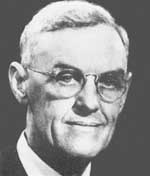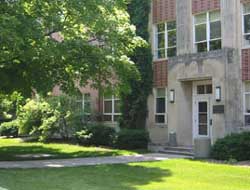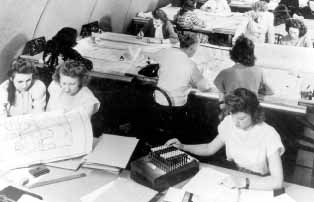Tales of Statisticians
George W Snedecor
20 Oct 1881 - 15 Feb 1974Statistics is the ultimate applied science. Many of its major contributors have had careers, not in mathematics, but in some field which makes regular contact with data. Snedecor's life runs the other way: he began in math and moved in an empirical direction. He was born in Memphis, the oldest of eight children of a lawyer turned minister. He studied mathematics and physics at Alabama Polytechnic, the University of Alabama, and the University of Michigan, receiving degrees in both subjects. He became a professor of mathematics at Iowa State, located in Ames, Iowa, in 1913. Then things started.
Contact with reality led Snedecor the mathematician to offer the first course in statistics. Over in Des Moines, Henry Wallace, born in 1888, a 1910 graduate of Iowa State, and then the editor of the family paper Wallace's Farmer, was also interested in agricultural research. In 1924, the two organized a weekly seminar to study multiple regression, and pioneered in the use of punched cards in data analysis; they published Correlation and Machine Calculation in 1925. With his colleague A E Brandt, Snedecor established in 1927 a Mathematical Statistical Service, then located in the Iowa State Mathematics Department, to offer campus-wide statistical consultation.
In 1931, Snedecor invited Ronald Fisher to visit Ames, and the stimulation of Fisher's presence pushed things to a higher level. Very likely with Fisher's situation at Rothamstead somewhere in the background, the Mathematical Statistical Service grew into the Iowa State Statistics Laboratory in 1933, with Snedecor as Director. It was the first thing of its kind in the United States. In 1934, Snedecor published a book on the analysis of variance, developing one of Fisher's pioneering contributions. His famous general textbook, Statistical Methods, was published in 1937. In anticipation of its appearance, Fisher wrote on 23 January 1936:
I think it is a splendid idea to exchange with Wishart, if it can be done, especially as that will bring you for a time to England. I certainly do not think that you need rank yourself less of a mathematician than Wishart, and should advise that you let the course you give be entirely your own rather than add to your difficulties by trying to follow the line of courses previously given. The material of your coming text, which I shall be very glad to see when it appears, would probably be entirely suitable for the Cambridge group.
With Fisher's agreement, his publishers, Oliver and Boyd, granted permission for the use of some of Fisher's tables in Snedecor's work. Finally the book came out. Fisher responded on 7 October 1937:
Very many thanks for sending me a signed copy of your fine book on Statistical Methods. I had only previously seen the advertisement, and am now looking through it. I am glad to see how much ground you have covered, with good illustrative examples which do so much to help the general reader, and which I had anticipated would be thoroughly well done. I am quite sure that students here will find the book most valuable.
With William G Cochran as eventual co-author, the book went through seven editions, and was translated into as many languages. Its viewpoint and examples are resolutely practical and agrarian. In 1939, a new building was erected to house the Department of Statistics, now separate from Mathematics (the first Master's degree in Statistics had been given to Gertrude Cox in 1931), and the associated Statistics Lab:
As for Henry Wallace, he had bolted his father's party for the Democrats and campaigned for Al Smith in 1928. Having thus attracted the attention of Franklin Roosevelt, he served under Roosevelt from 1933 to 1940 as Secretary of Agriculture (a post his father had earlier held under Harding and Coolidge), and became the second most important figure, after Roosevelt himself, in the New Deal policies.
Under Wallace's administration, the Agrculture Department's research center at Beltsville Maryland became the largest and most varied agricultural station in the world. Wallace went on to become Vice President during Roosevelt's third term. It was his high point. Under pressure from dominant elements in the Democratic Party, he was replaced on the ticket by Truman in 1944.
The F distribution, discovered by Snedecor in the course of this early work, and called F after Fisher, describes the ratio between the mean of the parent population as calculated by two samples of slightly different size. It is a key element in the study of analysis of variance.
The Statistical Lab was going great guns, though in a temporary building, in 1947. Snedecor was Director in that year. There followed many recognitions. He served as President of the American Statistical Association in 1948. On the recommendation of Fisher (the outgoing President of its Council), the Royal Statistical Society voted to make Snedecor an Honorary Fellow in 1954. In a latter supplementing the official notification, Fisher wrote, on 24 June 1954,
May I add my personal congratulations on an honour which is intended to show the high esteem in which your work is held in this country.
Snedecor was awarded honorary doctorates of science by North Carolina State in 1956 and, being thus reminded, by Iowa State iteself in 1958. Better late than later. Beginning in 1958, Snedecor served for five years as consultant to the U S Naval Electronics Laboratory in San Diego. The building housing the Department of Statistics at Iowa State was extended in 1961, and named Snedecor Hall in 1969. Snedecor was awarded the Samuel S Wilks Medal by the American Statistical Association in 1970.
The George W Snedecor Award, established in 1976, two years after Snedecor's death, and reduced to a biannual interval in 1991, is given by the American Statistical Association for a significant contribution to biometry. The F distribution, named by Snedecor after Fisher, is also frequently called "Snedecor's F" in recognition of Snedecor's own contribution. It is his chief monument.
Statistics is Copyright © 2001- by E Bruce Brooks
9 Jan 2006 / Contact The Project / Exit to Statistics Page



